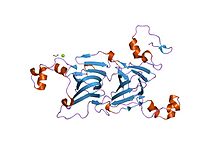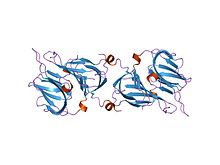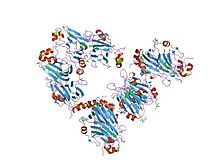Cupin superfamily
| Cupin_1 | |||||||||
|---|---|---|---|---|---|---|---|---|---|
 crystal structure of oxalate decarboxylase formate complex | |||||||||
| Identifiers | |||||||||
| Symbol | Cupin_1 | ||||||||
| Pfam | PF00190 | ||||||||
| Pfam clan | CL0029 | ||||||||
| InterPro | IPR006045 | ||||||||
| SCOP2 | 2phl / SCOPe / SUPFAM | ||||||||
| |||||||||
| Cupin_2 | |||||||||
|---|---|---|---|---|---|---|---|---|---|
 crystal structure of yxag, a dioxygenase from Bacillus subtilis | |||||||||
| Identifiers | |||||||||
| Symbol | Cupin_2 | ||||||||
| Pfam | PF07883 | ||||||||
| Pfam clan | CL0029 | ||||||||
| InterPro | IPR013096 | ||||||||
| SCOP2 | 1vj2 / SCOPe / SUPFAM | ||||||||
| |||||||||
| Cupin_3 | |||||||||
|---|---|---|---|---|---|---|---|---|---|
 crystal structure of protein ylba from E. coli, pfam duf861 | |||||||||
| Identifiers | |||||||||
| Symbol | Cupin_3 | ||||||||
| Pfam | PF05899 | ||||||||
| Pfam clan | CL0029 | ||||||||
| InterPro | IPR008579 | ||||||||
| SCOP2 | 1o5u / SCOPe / SUPFAM | ||||||||
| |||||||||
| Cupin_4 | |||||||||
|---|---|---|---|---|---|---|---|---|---|
| Identifiers | |||||||||
| Symbol | Cupin_4 | ||||||||
| Pfam | PF08007 | ||||||||
| Pfam clan | CL0029 | ||||||||
| |||||||||
| Cupin_5 | |||||||||
|---|---|---|---|---|---|---|---|---|---|
 x-ray crystal structure of protein so0799 from Shewanella oneidensis. northeast structural genomics consortium target sor12. | |||||||||
| Identifiers | |||||||||
| Symbol | Cupin_5 | ||||||||
| Pfam | PF06172 | ||||||||
| Pfam clan | CL0029 | ||||||||
| InterPro | IPR009327 | ||||||||
| |||||||||
| Cupin_6 | |||||||||
|---|---|---|---|---|---|---|---|---|---|
| Identifiers | |||||||||
| Symbol | Cupin_6 | ||||||||
| Pfam | PF12852 | ||||||||
| Pfam clan | CL0029 | ||||||||
| |||||||||
| Cupin_7 | |||||||||
|---|---|---|---|---|---|---|---|---|---|
| Identifiers | |||||||||
| Symbol | Cupin_7 | ||||||||
| Pfam | PF12973 | ||||||||
| Pfam clan | CL0029 | ||||||||
| |||||||||
The cupin superfamily is a diverse superfamily of proteins named after its conserved barrel domain (cupa being the Latin term for a small barrel). The superfamily includes a wide variety of enzymes as well as non-enzymatic seed storage proteins.[1][2]
Members of the superfamily play a role in allergy, especially seed storage proteins like 7S and 11S globulins, also known as vicilins and legumins, respectively. These proteins can be found at high concentrations in seeds of both mono- and dicotyledonous plants and are an important component of the normal human diet.
History
Thomas Burr Osborne at the end of the 19th century was the first person to systematically study seed storage proteins by their solubility characteristics. He established 4 classes of proteins: water-soluble albumins; salt soluble globulins: vicilin—typically having sedimentation coefficients, S values (a measure of the protein mass determined by sedimentation equilibrium ultracentrifugation) of about 7 Svedberg units (hence the common name 7S globulin) and legumin (11S); alcohol/water-soluble—cereal—prolamines; and a fourth class, glutelins, of difficultly soluble proteins no longer recognized and now considered low solubility prolamin or globulin storage proteins . Gluten consists of a mixture of prolamins: 'glutenin' and 'gliadin'. Osborne and his Yale colleague Lafayette Mendel are considered the 'founders' of the modern science of nutrition.
Earlier, the fungi Sclerotinia sclerotiorum (Lib.) deBary was the first oxalic acid (oxalate), secreting organism to be described as early as 1886 in Botan. Z. by A. de Barry. However, since oxalate secreting fungi are not a major threat to crop cereals no studies of this interaction were made for almost 100 years. In the early 1980s a protein dubbed 'germin' was identified in germinating wheat embryos; and in the early 1990s (1992) it was found to be an enzyme having oxalate oxidase (OXO) activity converting an oxalate substrate into carbon dioxide and hydrogen peroxide. This latter-day discovery of 'germin' was soon followed by the discovery of the 'cupin superfamily' of proteins.
Classification
Legumin and vicilin share a common evolutionary ancestor, namely, a vicilin-like protein in a fern-spore which also exhibits some characteristics of legumin. Each of these proteins contains equivalent 'subunits' indicating an evolution from a single-gene ancestor which has been duplicated during evolution. It was suggested that "germin" , {first found and only known to occur in the "true cereals": barley, corn, oat, rice, and wheat} a plant enzyme, oxalate oxidase 'one-very-tough-little- protein' was such an ancestor. This hypothesis stimulated a search for the evolutionary roots of the seed storage globulins which include such food proteins as the legume soy protein—the gold standard for plant-based proteins—due to its balanced content of 7S and 11S globulin protein, other beans, the pseudocereals buckwheat, & quinoa, pumpkin seeds, cocoa, coffee, nuts, and the two cereals oats and rice.
This search turned up a new realm: that seed storage globulin proteins (7S & 11S), as well as many other non-storage plant proteins {notably germins (G-OXOs), germin-like proteins (GLPs)} and microbial proteins belong to a vast superfamily of proteins dubbed the 'cupin superfamily' of proteins, named on the basis of a conserved beta-barrel fold (cupa the Latin term for a small barrel) originally discovered within germin and germin-like proteins from higher plants. Germin is a monocupin and 7S & 11S are each bicupins. It is a large and functionally immensely diverse 'superfamily' of proteins, numbering in the thousands, that have a common origin and whose evolution can be followed from bacteria to eukaryotes including animals and higher plants. "Cupins" are the most functionally diverse protein superfamily occurring in all spermatophytes (seed bearing plants). " GLPs, moreover, are now known to be ubiquitous plant proteins, no longer linked only to cereal germination, but involved in plant responses to biotic and abiotic stress.[3] "G-OXOs and GLPs are plant do-all proteins."[4]
Germin of the "true cereals" is known as the 'archetypal' member of the cupin superfamily, however it is not to be considered an empty cask or barrel but a 'jellyroll' jelly roll fold in which six monomer subunits are wrapped in three dimensions to form a barrel shape. This structure accounts for its astonishing 'refractory' nature toward various 'denaturing' agents: all germins share a remarkable stability when subjected to heat, detergents, extreme pH and resistance to broad specificity proteolytic (digestive) enzymes. Seed storage proteins of grasses and cereals belong to the eponymous prolamin superfamily which also includes plant albumins(2S). Prolamin seed storage proteins so characteristic of cereals and grasses is not considered very nutritious because of its high content of the amino acid proline which it shares with gelatin and its low content of lysine, a vital amino acid.
Germin was initially identified in the early stages of wheat seed germination, thus its name. Domesticated cereals most notably 'hexaploid' bread wheat ( pasta wheat is tetraploid) was selected by humans for its resistance to fungal pathogens. Many years later it was found to have oxalate oxidase activity generating 'antimicrobial' hydrogen peroxide from a substrate of the double-acid, oxalic acid, secreted by an invading fungus or other microbe. A reaction between oxalate and the calcium cation makes calcium oxalate, a type of 'kidney stone' in humans. Amazingly, oxalate is a metabolite of ascorbate (vitamin C), and it is worth emphasizing that ascorbate is a direct precursor of oxalate in plants.
Application
The 'sweetest' outcome from our knowledge of germin biochemistry is that the wheat-germin gene is the obvious candidate for insertion into the American chestnut for producing a transgenic American chestnut. This tree called the "perfect tree" has no resistance to Cryphonectria parasitica, the chestnut blight fungus.[5] The fungal mycelium produce oxalic acid which eats away at the tree's bark giving it a portal into the underlying growing tissue. The xylem vessels carrying water become plugged through the chelation of calcium cations by oxalate just as in the kidney. Death is by strangulation as a canker encircles and girdles the trunk.
Transgenic American chestnut seedlings have been produced and field tested carrying the wheat germin gene for oxalate oxidase which breaks down oxalic acid the caustic chemical excreted by the invasive chestnut blight fungus.[6]
Soybean Protein Nomenclature: Aprogress.[7] Effects of ionic strength on the ultracentrifuge pattern for water-extractable soybean proteins at pH 7.6. The terminology used most extensively in the past.
References
- ^ Dunwell JM (1998). "Cupins: a new superfamily of functionally diverse proteins that include germins and plant storage proteins". Biotechnology & Genetic Engineering Reviews. 15: 1–32. doi:10.1080/02648725.1998.10647950. PMID 9573603.
- ^ Dunwell JM, Purvis A, Khuri S (January 2004). "Cupins: the most functionally diverse protein superfamily?". Phytochemistry. 65 (1): 7–17. doi:10.1016/j.phytochem.2003.08.016. PMID 14697267.
- ^ Dunwell, Jim; Gibbings, J. George; Mahmood, Tariq; Saqlan Naqvi, S.M. (2008-09-01). "Germin and Germin-like Proteins: Evolution, Structure, and Function" (PDF). Critical Reviews in Plant Sciences. 27 (5): 342–375. doi:10.1080/07352680802333938.
{{cite journal}}: Unknown parameter|name-list-format=ignored (|name-list-style=suggested) (help) - ^ Bernier, François; Berna, Anne (July 2001). "Germins and germin-like proteins: Plant do-all proteins. But what do they do exactly?". Plant Physiology and Biochemistry. 39 (7–8): 545–554. doi:10.1016/S0981-9428(01)01285-2.
- ^ "American Chestnut". www.susanfreinkel.com. Retrieved 2016-12-17.
- ^ https://www.nytimes.com/2020/04/30/magazine/american-chestnut.html
- ^ "Download from National Agricultural Library Digital Collections". naldc.nal.usda.gov. Retrieved 2016-12-17.
